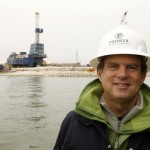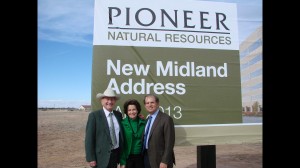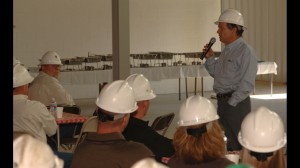Pioneering Spirit
The President and CEO of Pioneer Natural Resources, Scott Sheffield,  combines a global perspective with West Texas savvy to help fuel a resurgence in the Basin.
combines a global perspective with West Texas savvy to help fuel a resurgence in the Basin.
When Teri Pender joined a small independent in Midland 30 years ago as an auditor, she occasionally had to ask questions of a petroleum engineer who always politely gave her answers. Parker & Parsley grew into a large independent and the role of that engineer, Scott Sheffield, expanded exponentially until he was named president.
Today, that engineer leads Pioneer Natural Resources as president and CEO of the third-largest drilling company in the United States—a firm that is re-focusing efforts back into West Texas, the site of the predecessor company’s operations.
Despite the industry’s ups and the downs and the firm’s corresponding economics, Sheffield focuses not just on Pioneer’s bottom line but on the ingredient essential to keeping the bottom line from dropping: his 3,500 employees.
“He has always recognized people are important to the company,” Pender said. “For his birthday in June, Scott wanted to give back to the people who have supported him for years. All the people are important to him. He has a great memory—he remembers everyone’s name. And he really listens to the people.”
 As the company grew, so did Sheffield’s leadership skills, she noted. He was named president of Parker & Parsley in 1985 and chairman and CEO in 1991. The company was a $1.5 billion enterprise when it merged with Mesa Inc. in 1997 to form Pioneer Natural Resources. The ability to review data, forecast possible impacts, and envision the whole picture serves Sheffield well and keeps Pioneer in place as one of the country’s top successful drilling operations.
As the company grew, so did Sheffield’s leadership skills, she noted. He was named president of Parker & Parsley in 1985 and chairman and CEO in 1991. The company was a $1.5 billion enterprise when it merged with Mesa Inc. in 1997 to form Pioneer Natural Resources. The ability to review data, forecast possible impacts, and envision the whole picture serves Sheffield well and keeps Pioneer in place as one of the country’s top successful drilling operations.
A bio reveals his early years as typical. He was born in Dallas and the family moved to Houston when he was 2. His father was a petroleum engineer with ARCO Oil & Gas and by the time Scott was ready for high school, the family had been transferred to Tehran, Iran. Scott attended the American High School, played football, was elected student class president , and was graduated in 1970. He headed back to the States and to the University of Texas where, after starting in pre-law, he was graduated with a bachelor’s degree in petroleum engineering. His first employer—Amoco Production—sent Sheffield to Odessa for two years and then to Houston for three. He then got the call to join a start-up independent in Midland as the sole engineer.
That’s when Teri Pender met him, as did James Cunningham, who signed on with Parker & Parsley in November 1981 as field superintendent. “I was in the  field and Scott was the engineer in the office,” he recalled. Over the years, he developed a high level of respect for the man who rose to the level of company president.
field and Scott was the engineer in the office,” he recalled. Over the years, he developed a high level of respect for the man who rose to the level of company president.
“I think very, very highly of Scott,” said Cunningham, who now serves as vice president of field operations. “He is a very honest man and a people person. Scott always stuck to the promises he made us. When Scott took over as president, he said he would share the wealth with us, and he has. Even during troubled years, Scott found a way to reward his employees.”
When Cunningham was asked in 1979 to move to Argentina to handle the company’s operations, he agreed. “I said then that I would go anywhere in the world for Scott.” After five years, Cunningham was assigned to Dallas and then sent back to Midland a year ago to help with the company’s expanding role in the Spraberry.
With a drilling boom underway in the Permian Basin and the price of oil hovering in the $80 per barrel range, Sheffield works to move the company forward. He and his team daily focus on national and world events, the worldwide economy, the Basin’s infrastructure, and local office needs. Through the years he learned the industry is constantly changing and evolving.
When he moved Pioneer Natural Resources’ headquarters to Dallas in 1997, he said, “I thought the Permian Basin was drilled up and all we could do was make acquisitions.” Speaking at the Executive Oil Conference in April, Sheffield told the audience his company decided at that point to focus on international efforts. The company pulled out of the Spraberry and headed overseas. A few years ago, however, new technology re-invigorated the Spraberry and it is now the world’s top play.
 Having sold the last of their international assets, Pioneer Natural Resources has returned to the Permian Basin as a major player. According to the company’s website, it is the “largest acreage holder, driller, and producer in the field, with interests in more than 6,500 active wells. Spraberry operations represent approximately 35 percent of Pioneer’s current production and approximately 50 percent of total proved reserves.”
Having sold the last of their international assets, Pioneer Natural Resources has returned to the Permian Basin as a major player. According to the company’s website, it is the “largest acreage holder, driller, and producer in the field, with interests in more than 6,500 active wells. Spraberry operations represent approximately 35 percent of Pioneer’s current production and approximately 50 percent of total proved reserves.”
Pioneer also is the largest operator in the gas-rich Raton basin in southeastern Colorado and is one of the largest operators in the Hugoton gas field in Kansas and the West Panhandle gas field in the Texas Panhandle. Further, Pioneer has been the most active driller in the South Texas Eagle Ford play. The company also has reached up to Alaska, where it discovered the Oooguruk oil field in 2003, becoming the first independent to operate a producing field on the North Slope.
Back in the Permian Basin, this boom generates its own set of problems and right now that is infrastructure, Sheffield noted. “In the Midland area, WTI is discounted by an extra $4 to $5 per barrel in order to move crude through what has become very constrained infrastructure in the Permian Basin to Cushing, Oklahoma.” The result, Sheffield said, is that when oil is $80 a barrel, local producers are receiving less than that amount.” Meanwhile, prices for natural gas liquids have dropped.
“To offset part of the drop in oil and liquids prices, we are taking steps to reduce our costs to drill and develop wells and also our operating costs,” he said. “Working together to reduce costs in step with lower oil prices will be key to maintaining the level of activity and growth in the Permian Basin. If the producers and the service companies work together, even at $80 a barrel for crude, projects should still generate acceptable returns. The Permian Basin will still be very active and the need for more and better infrastructure, services, and housing will continue to be strong.”
Sheffield sees some relief in the pipeline infrastructure starting in early 2014  when the Longhorn Pipeline will be ready to take products from Crane to the Gulf Coast. That will be followed in mid-2014 by the Bridge Tex Pipeline launched by Magellan Midstream Partners and Occidental Petroleum Corp. and running from Colorado City to the Gulf Coast. Two more pipelines are in the planning stage, Sheffield noted, with one starting in Crane and the other also in Colorado City.
when the Longhorn Pipeline will be ready to take products from Crane to the Gulf Coast. That will be followed in mid-2014 by the Bridge Tex Pipeline launched by Magellan Midstream Partners and Occidental Petroleum Corp. and running from Colorado City to the Gulf Coast. Two more pipelines are in the planning stage, Sheffield noted, with one starting in Crane and the other also in Colorado City.
“These will bypass Cushing and that bottleneck,” he said. “The faster we can get our products to the Gulf Coast, then [the faster that] Midland producers can receive higher prices.” These four new lines already are almost completely committed.
The current drilling boom and the upspike in the amount of oil and products being brought to the surface is headline-grabbing, but it is not completely out of line with other historic highs within the Permian. Sheffield recalled that in the 1970s boom “the Permian Basin reached 2 million barrels per day.” However, there were more pipelines for shipping the products to refineries. “A lot of those pipelines were mothballed or used for other products. I’ve heard some are being reversed” [to be used for petroleum products], he said.
With oil sticking at $80 per barrel, Sheffield expects to see the rig count drop in the coming weeks. “We (Pioneer Natural Resources) are dropping 10 vertical rigs in the Basin, going to 30 from 40. We have four horizontal rigs, and we are adding three by the end of the year. So, that leaves us a net drop of seven rigs. I’ve heard of some other producers who also are dropping rigs.”
That drop in rigs might also encourage service companies to reduce their prices, which would keep other rigs in operation. “It takes about six months for the service costs to get more competitive,” Sheffield noted. “If there is a 10 to 15 percent drop in their costs then we can drill more wells. I’m hoping we see this.”
Sheffield said Pioneer will continue to hire employees as the need dictates. With Pioneer’s focus shifting back to the Permian Basin, the company has found itself squeezed into its downtown Midland office space. Last spring the company purchased land on North Big Spring Street and a new office building should be completed by early 2014.
With the office space issue solved, Pioneer has turned its attention to housing employees—part of the infrastructure that Permian Basin towns are lacking. “Even if the rig count drops to 400 or 450, people are still coming here to work,” Sheffield said. The company is renting hotel rooms and trailer homes for employees and will be constructing a “man camp” on East Highway 80 outside Midland. “It’s not far from our Highway 80 office. This will be modular housing just for men,” he explained.
The drop in oil price, Sheffield said, “is just a hiccup. It gives the mayors and city councils and other investors more time to move forward on projects like hotels, apartment complexes, and housing.”
The housing shortage also has impacted companies in their ability to hire young professionals. That is the same reason, Sheffield recalled, why Pioneer Natural Resources moved its headquarters to the Dallas-Fort Worth area in 1997. “That was one of the reasons we moved. We wanted to attract the top talent among geologists and engineers. Most of the majors moved out of Midland for the same reason.”
“The shortage of housing, hotels, retail establishments, and health services has been a real hindrance to local communities, limited their ability to fully capture the economic opportunity of new shale oil development,” he continued. “Midland is now one of the fastest-growing cities in the U.S., and Permian Basin businesses and community leaders will need to ensure that communities and schools continue to anticipate and plan for additional growth.”
Sheffield’s vision also extends to world events and he anticipates how they will impact the national economy and, thus, the need for more oil.
“Europe, China, and the U.S. economies are not growing,” he noted. OPEC (Organization of Petroleum Exporting Countries) can adjust back on how much they produce each day. They (OPEC countries) really need $100 a barrel for crude to balance their budgets. Right now, they could make up for some of the loss at $80 a barrel if they cut back on their production.”
For months the world has been focusing on Iran and its unstable political climate. Does it have nuclear weapons? Will it launch rockets at Israel? What is happening to its oil production? When Sheffield lived in Iran the Shah was in power.
 He expects Iran to take some kind of action in the near future, and it may be in the form of closing the Strait of Hormuz. “They’ve been building up their navy, and several countries are no longer taking Iranian barrels of oil. Iran may get backed into a corner and do something in the Strait of Hormuz,” Sheffield said. An average of 14 crude tankers sail each day through that waterway, according to Bloomberg Businessweek. When the European Union embargoed purchases of Iranian crude starting July 1, Iranian officials threatened to retaliate by closing Hormuz to shipping.
He expects Iran to take some kind of action in the near future, and it may be in the form of closing the Strait of Hormuz. “They’ve been building up their navy, and several countries are no longer taking Iranian barrels of oil. Iran may get backed into a corner and do something in the Strait of Hormuz,” Sheffield said. An average of 14 crude tankers sail each day through that waterway, according to Bloomberg Businessweek. When the European Union embargoed purchases of Iranian crude starting July 1, Iranian officials threatened to retaliate by closing Hormuz to shipping.
Sheffield surmised that Iran could: Sink a couple of tankers, shoot missiles at Israel, team with Iraqis to put pressure on OPEC countries to back off on production, or stir up the Shiite population in Saudi Arabia. “There’s nothing longterm that Iran can do,” he suggested.
Despite what goes on in the Middle East or Europe, the head of Pioneer says “the future of the Basin is bright, with 20 percent of the oil reserves coming out of here. This basin has the largest rig count in the United States.”
Teri Pender looked back on her years with, at first, Parker & Parsley, and then Pioneer Natural Resources—all the time under Sheffield’s leadership. “In his position he has to make the tough decisions. I remember when we had to have layoffs [in the late 1990s] and it was tough on him. When we had a downturn in 2008-09, Scott was determined not to lay off anyone. To just cut expenses. We made it through without layoffs.”
Cunningham added, “Scott has earned our respect and I speak for a lot of oilfield people. He’s very well respected in the industry.”









